brake fluid TOYOTA COROLLA CROSS HYBRID 2023 Owners Manual
[x] Cancel search | Manufacturer: TOYOTA, Model Year: 2023, Model line: COROLLA CROSS HYBRID, Model: TOYOTA COROLLA CROSS HYBRID 2023Pages: 516, PDF Size: 15.96 MB
Page 342 of 516
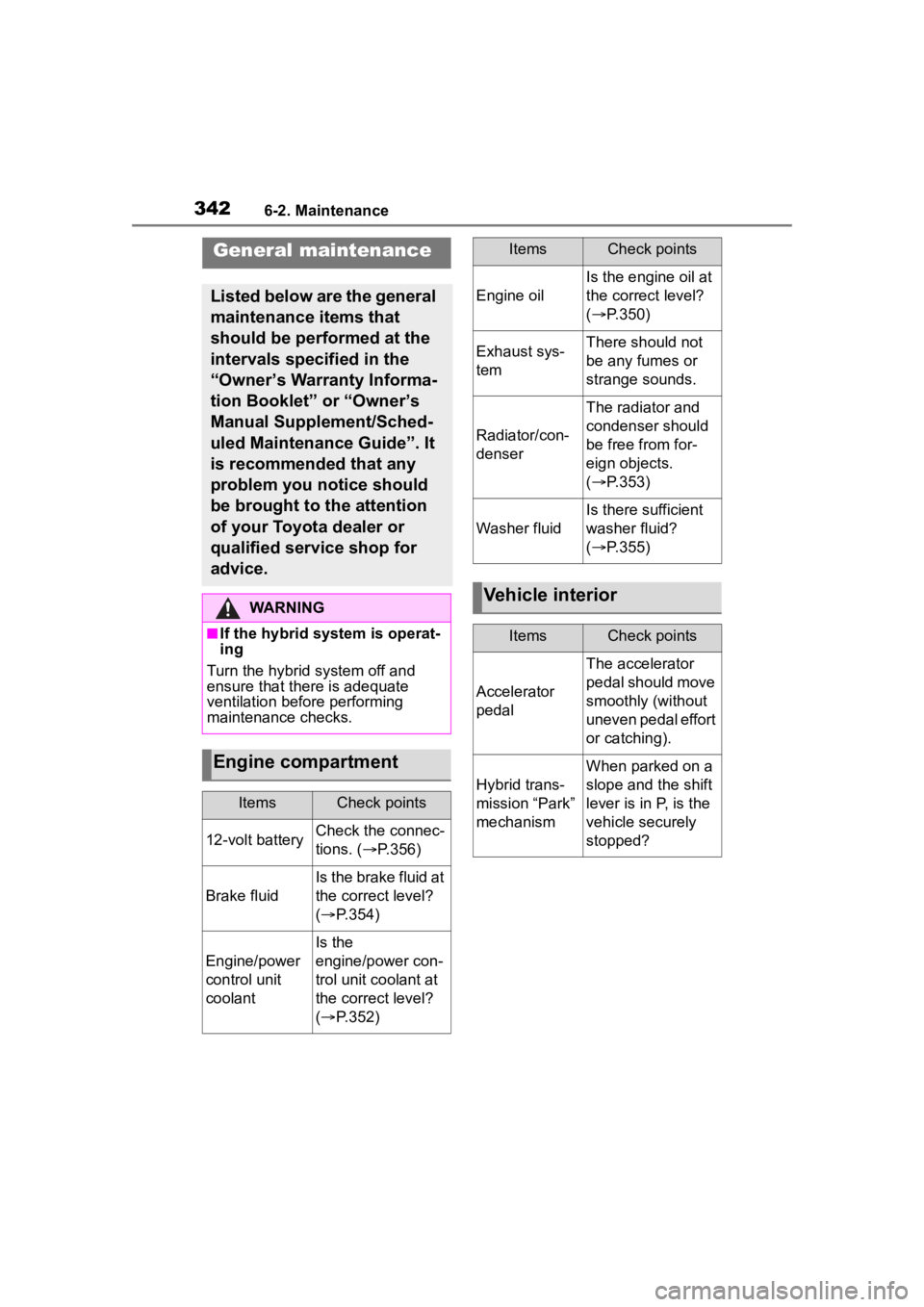
3426-2. Maintenance
General maintenance
Listed below are the general
maintenance items that
should be performed at the
intervals specified in the
ŌĆ£OwnerŌĆÖs Warranty Informa-
tion BookletŌĆØ or ŌĆ£OwnerŌĆÖs
Manual Supplement/Sched-
uled Maintenance GuideŌĆØ. It
is recommended that any
problem you notice should
be brought to the attention
of your Toyota dealer or
qualified service shop for
advice.
WARNING
Ō¢ĀIf the hybrid system is operat-
ing
Turn the hybrid system off and
ensure that there is adequate
ventilation before performing
maintenance checks.
Engine compartment
ItemsCheck points
12-volt batteryCheck the connec-
tions. ( ’é«P.356)
Brake fluid
Is the brake fluid at
the correct level?
(’é« P.354)
Engine/power
control unit
coolant
Is the
engine/power con-
trol unit coolant at
the correct level?
(’é« P.352)
Engine oil
Is the engine oil at
the correct level?
(’é« P.350)
Exhaust sys-
temThere should not
be any fumes or
strange sounds.
Radiator/con-
denser
The radiator and
condenser should
be free from for-
eign objects.
(’é« P.353)
Washer fluid
Is there sufficient
washer fluid?
(’é« P.355)
Vehicle interior
ItemsCheck points
Accelerator
pedal
The accelerator
pedal should move
smoothly (without
uneven pedal effort
or catching).
Hybrid trans-
mission ŌĆ£ParkŌĆØ
mechanism
When parked on a
slope and the shift
lever is in P, is the
vehicle securely
stopped?
ItemsCheck points
Page 346 of 516
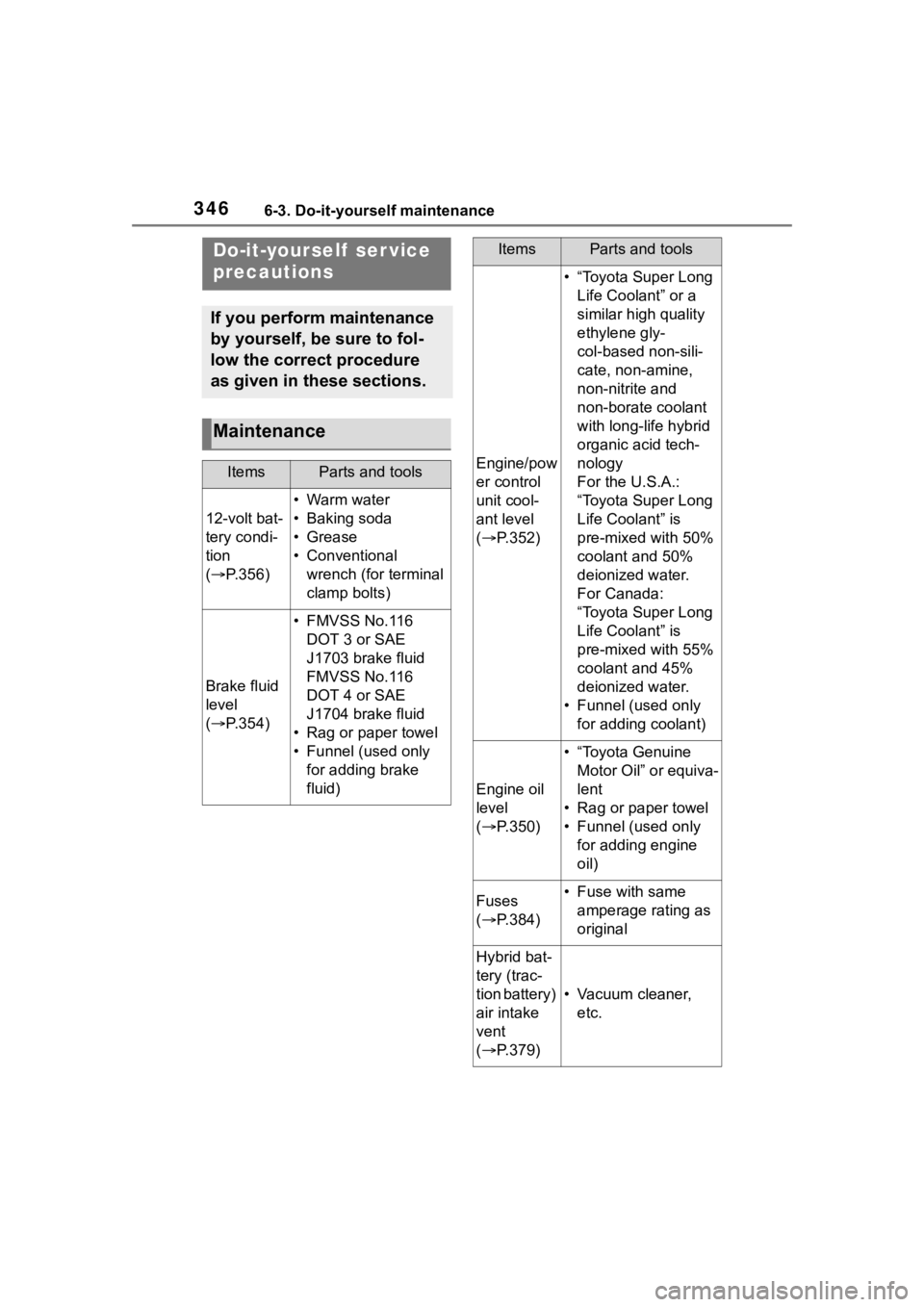
3466-3. Do-it-yourself maintenance
6-3.Do-it-yourself maintenance
Do-it-yourself ser vice
precautions
If you perform maintenance
by yourself, be sure to fol-
low the correct procedure
as given in these sections.
Maintenance
ItemsParts and tools
12-volt bat-
tery condi-
tion
(’é« P.356)
ŌĆóWarm water
ŌĆó Baking soda
ŌĆóGrease
ŌĆó Conventional
wrench (for terminal
clamp bolts)
Brake fluid
level
(’é« P.354)
ŌĆó FMVSS No.116
DOT 3 or SAE
J1703 brake fluid
FMVSS No.116
DOT 4 or SAE
J1704 brake fluid
ŌĆó Rag or paper towel
ŌĆó Funnel (used only for adding brake
fluid)
Engine/pow
er control
unit cool-
ant level
(’é« P.352)
ŌĆó ŌĆ£Toyota Super Long
Life CoolantŌĆØ or a
similar high quality
ethylene gly-
col-based non-sili-
cate, non-amine,
non-nitrite and
non-borate coolant
with long-life hybrid
organic acid tech-
nology
For the U.S.A.:
ŌĆ£Toyota Super Long
Life CoolantŌĆØ is
pre-mixed with 50%
coolant and 50%
deionized water.
For Canada:
ŌĆ£Toyota Super Long
Life CoolantŌĆØ is
pre-mixed with 55%
coolant and 45%
deionized water.
ŌĆó Funnel (used only for adding coolant)
Engine oil
level
(’é« P.350)
ŌĆó ŌĆ£Toyota Genuine
Motor OilŌĆØ or equiva-
lent
ŌĆó Rag or paper towel
ŌĆó Funnel (used only for adding engine
oil)
Fuses
(’é« P.384)ŌĆó Fuse with same
amperage rating as
original
Hybrid bat-
tery (trac-
tion battery)
air intake
vent
(’é« P.379)
ŌĆó Vacuum cleaner,
etc.
ItemsParts and tools
Page 350 of 516

3506-3. Do-it-yourself maintenance
Washer fluid tank (’é« P.355)
Engine coolant reservoir ( ’é«P.351)
Fuse box (’é« P.384)
Engine oil filler cap (’é« P.351)
Engine oil level dipstick ( ’é«P.351)
Power control unit coolant reservoir ( ’é«P.352)
Brake fluid reservoir ( ’é«P.354)
Radiator (’é« P.353)
Condenser (’é« P.353)
Electric cooling fans
Ō¢Ā12-volt battery
’é« P. 3 5 6
With the engine at operating
temperature and turned off,
check the oil level on the dip-
Engine compar tment
Components
Checking and adding the
engine oil
Page 354 of 516
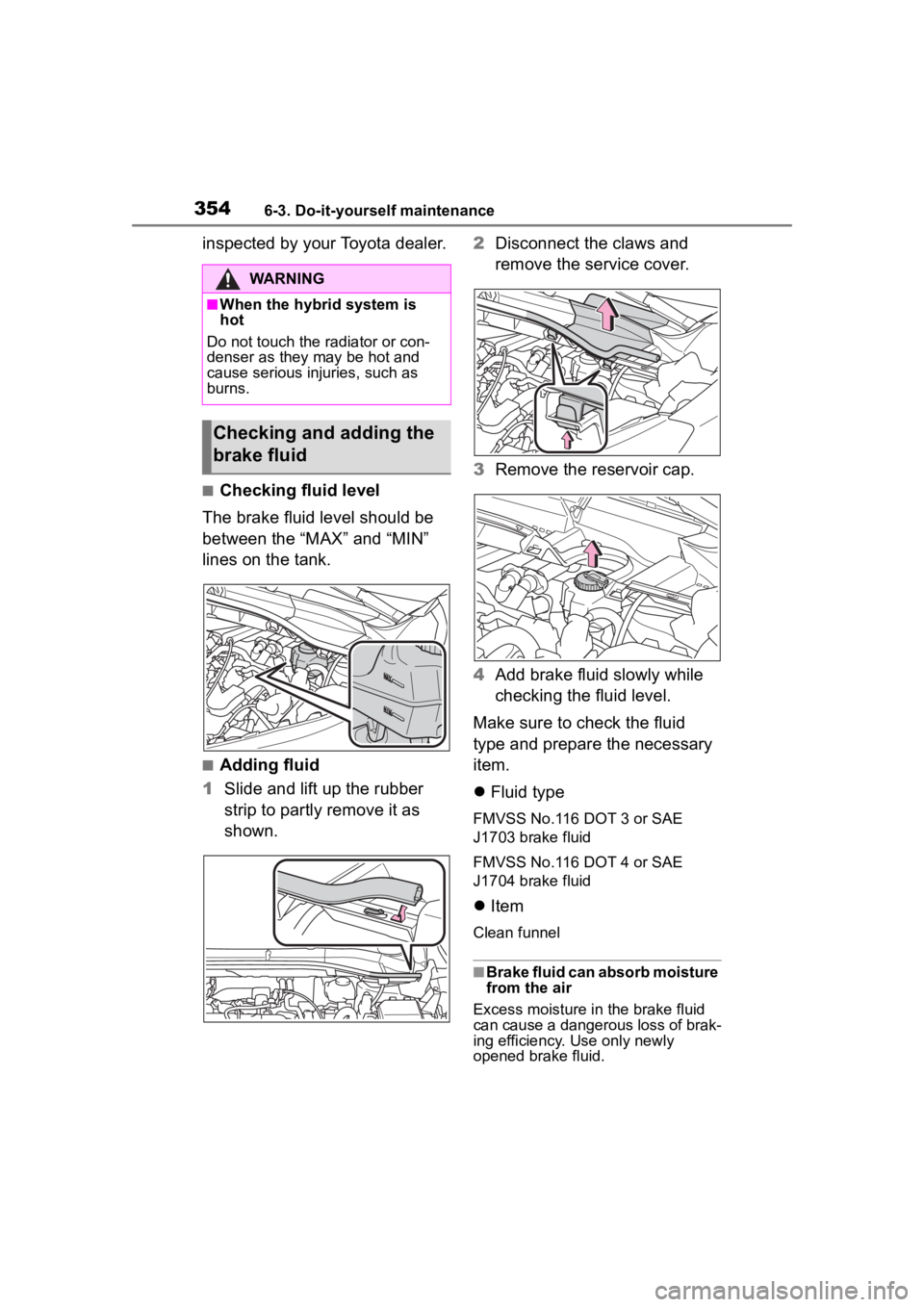
3546-3. Do-it-yourself maintenance
inspected by your Toyota dealer.
Ō¢ĀChecking fluid level
The brake fluid level should be
between the ŌĆ£MAXŌĆØ and ŌĆ£MINŌĆØ
lines on the tank.
Ō¢ĀAdding fluid
1 Slide and lift up the rubber
strip to partly remove it as
shown. 2
Disconnect the claws and
remove the service cover.
3 Remove the reservoir cap.
4 Add brake fluid slowly while
checking the fluid level.
Make sure to check the fluid
type and prepare the necessary
item.
’ü¼ Fluid type
FMVSS No.116 DOT 3 or SAE
J1703 brake fluid
FMVSS No.116 DOT 4 or SAE
J1704 brake fluid
’ü¼Item
Clean funnel
Ō¢ĀBrake fluid can absorb moisture
from the air
Excess moisture in the brake fluid
can cause a dangerous loss of brak-
ing efficiency. Use only newly
opened brake fluid.
WARNING
Ō¢ĀWhen the hybrid system is
hot
Do not touch the r adiator or con-
denser as they may be hot and
cause serious injuries, such as
burns.
Checking and adding the
brake fluid
Page 355 of 516

3556-3. Do-it-yourself maintenance
6
Maintenance and care
WARNING
Ō¢ĀWhen filling the reservoir
Take care as brake fluid can harm
your hands and eyes and damage
painted surfaces.
If fluid gets on your hands or in
your eyes, flush t he affected area
with clean water immediately.
If you still experien ce discomfort,
see a doctor.
NOTICE
Ō¢ĀIf the fluid level is low or high
It is normal for the brake fluid level
to go down slightly as the brake
pads wear out or when the fluid
level in the accumulator is high.
If the reservoir needs frequent
refilling, there may be a serious
problem.
Adding the washer fluid
WARNING
Ō¢ĀWhen adding washer fluid
Do not add washer fluid when the
hybrid system is hot or operating
as washer fluid contains alcohol
and may catch fire if spilled on the
engine, etc.
NOTICE
Ō¢ĀDo not use any fluid other
than washer fluid
Do not use soapy water or engine
antifreeze instead of washer fluid.
Doing so may cause streaking on
the vehicleŌĆÖs painted surfaces, as
well as damaging the pump lead-
ing to problems of the washer
fluid not spraying.
Ō¢ĀDiluting washer fluid
Dilute washer fluid with water as
necessary.
Refer to the freezing tempera-
tures listed on the label of the
washer fluid bottle.
Page 401 of 516

4017-2. Steps to take in an emergency
7
When trouble arises
’ü¼Fluid leaks under the vehicle.
(Water dripping from the air
conditioning after use is nor-
mal.)
’ü¼ Flat-looking tires or uneven
tire wear
’ü¼ Engine coolant temperature
gauge needle continually
points higher than normal.
’ü¼ Changes in exhaust sound
’ü¼ Excessive tire squeal when
cornering
’ü¼ Strange noises related to the
suspension system
’ü¼ Pinging or other noises
related to the hybrid system
’ü¼ Engine missing, stumbling or
running roughly
’ü¼ Appreciable loss of power
’ü¼ Vehicle pulls heavily to one side when braking
’ü¼ Vehicle pulls heavily to one
side when driving on a level
road
’ü¼ Loss of brake effectiveness,
spongy feeling, pedal almost
touches the floor
If you think something
is wrong
If you notice any of the fol-
lowing symptoms, your
vehicle probably needs
adjustment or repair. Con-
tact your Toyota dealer as
soon as possible.
Visible symptoms
Audible symptoms
Operational symptoms
Page 402 of 516
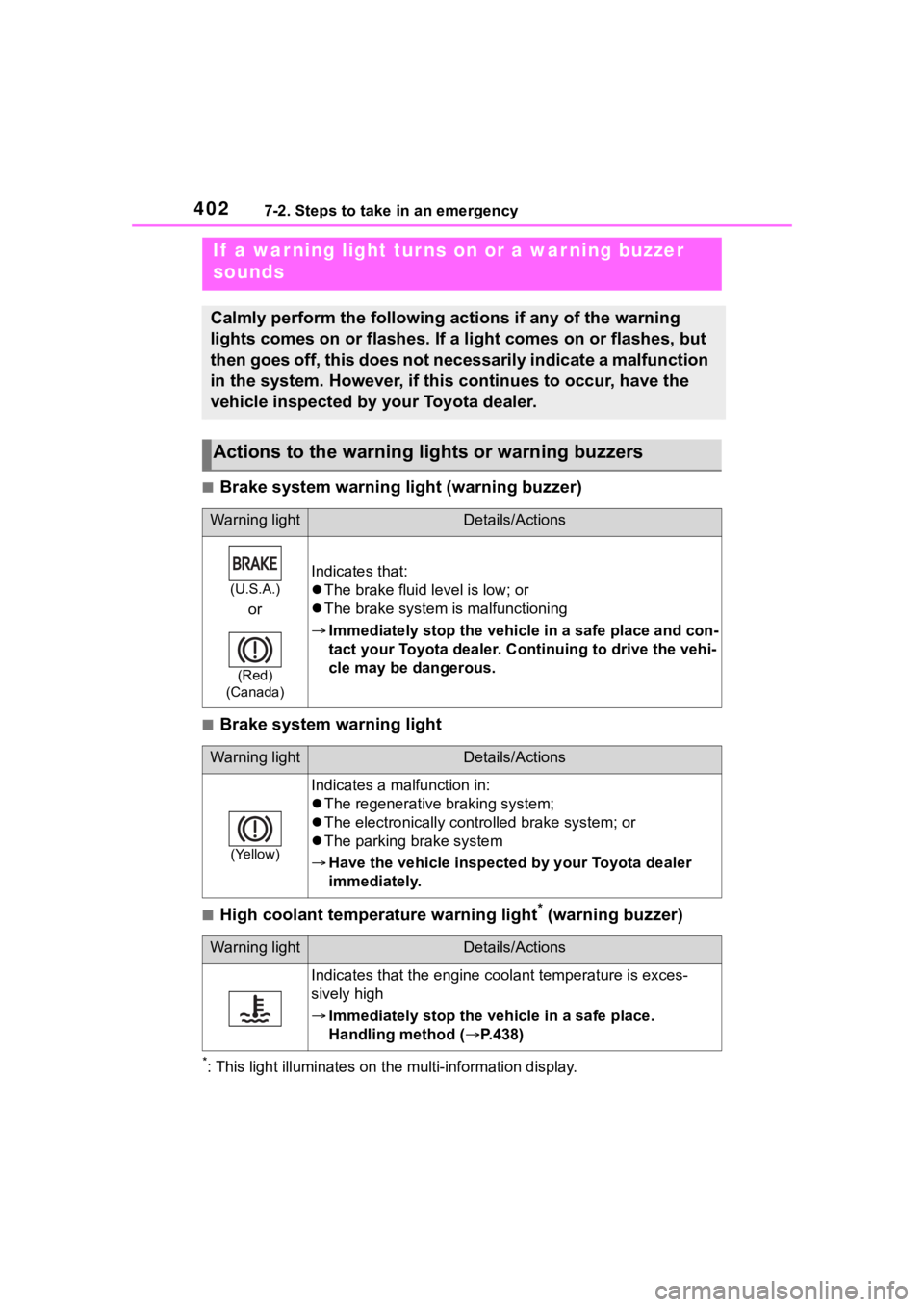
4027-2. Steps to take in an emergency
Ō¢ĀBrake system warning light (warning buzzer)
Ō¢ĀBrake system warning light
Ō¢ĀHigh coolant temperature warning light* (warning buzzer)
*: This light illuminat es on the multi-information display.
If a war ning light tur ns on or a war ning buzzer
sounds
Calmly perform the following actions if any of the warning
lights comes on or flashes. If a light comes on or flashes, but
then goes off, this does not necessarily indicate a malfunction
in the system. However, if this continues to occur, have the
vehicle inspected by your Toyota dealer.
Actions to the warning lights or warning buzzers
Warning lightDetails/Actions
(U.S.A.)
or
(Red)
(Canada)
Indicates that:
’ü¼ The brake fluid level is low; or
’ü¼ The brake system is malfunctioning
’é« Immediately stop the vehicle in a safe place and con-
tact your Toyota dealer. Continuing to drive the vehi-
cle may be dangerous.
Warning lightDetails/Actions
(Yellow)
Indicates a malfunction in:
’ü¼The regenerative braking system;
’ü¼ The electronically contr olled brake system; or
’ü¼ The parking brake system
’é« Have the vehicle inspected by your Toyota dealer
immediately.
Warning lightDetails/Actions
Indicates that the engine c oolant temperature is exces-
sively high
’é« Immediately stop the vehicle in a safe place.
Handling method ( ’é«P.438)
Page 449 of 516
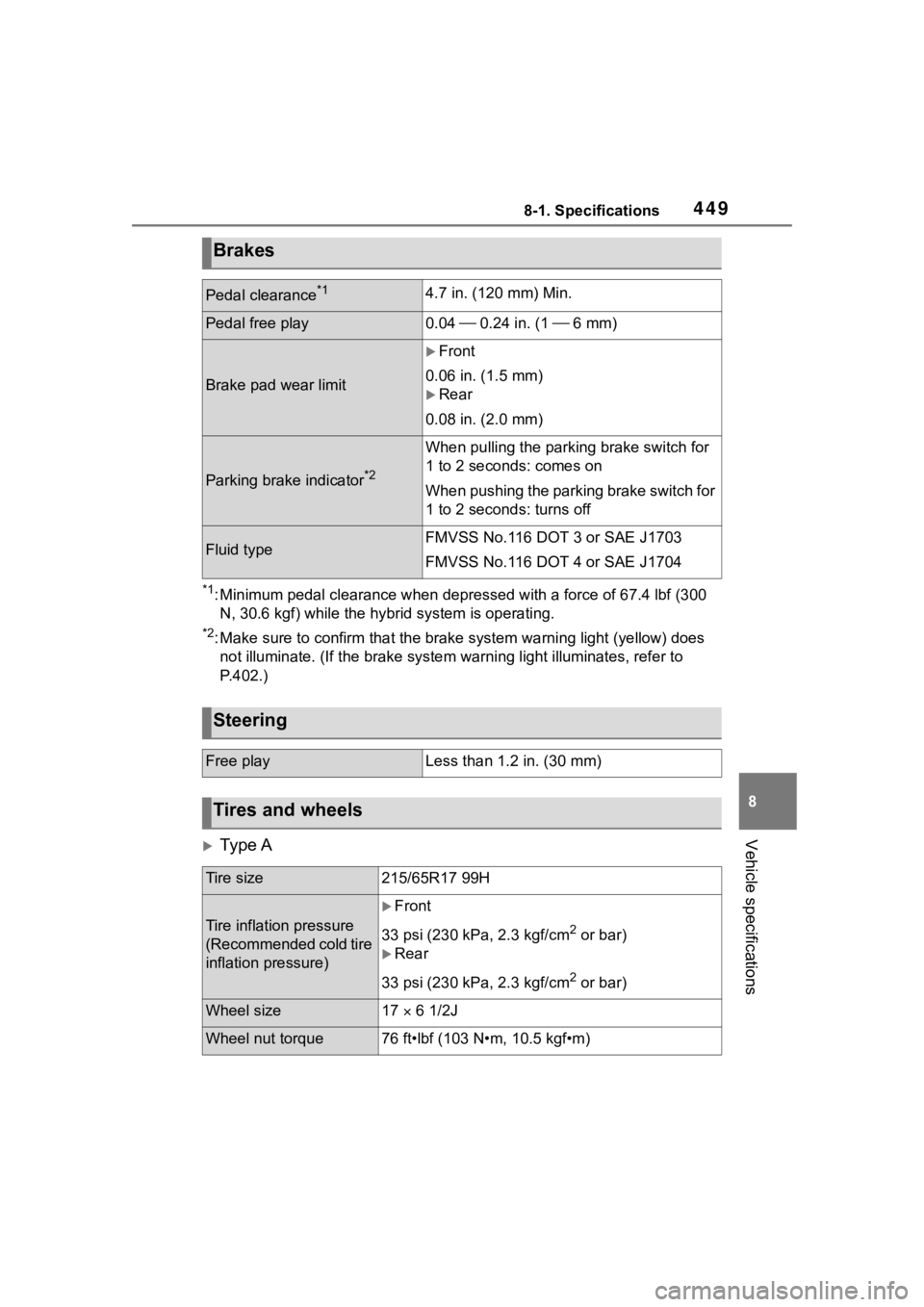
4498-1. Specifications
8
Vehicle specifications
*1: Minimum pedal clearance when depressed with a force of 67.4 lbf (300
N, 30.6 kgf) while the hyb rid system is operating.
*2: Make sure to confirm that the brake system warning light (yell ow) does
not illuminate. (If th e brake system warning light illuminates, refer to
P.402.)
’üĄTy p e A
Brakes
Pedal clearance*14.7 in. (120 mm) Min.
Pedal free play0.04 ’éŠ 0.24 in. (1 ’éŠ 6 mm)
Brake pad wear limit
’üĄFront
0.06 in. (1.5 mm)
’üĄRear
0.08 in. (2.0 mm)
Parking brake indicator*2
When pulling th e parking brake switch for
1 to 2 seconds: comes on
When pushing the parking brake switch for
1 to 2 seconds: turns off
Fluid typeFMVSS No.116 DOT 3 or SAE J1703
FMVSS No.116 DOT 4 or SAE J1704
Steering
Free playLess than 1.2 in. (30 mm)
Tires and wheels
Tire size215/65R17 99H
Tire inflation pressure
(Recommended cold tire
inflation pressure)
’üĄFront
33 psi (230 kPa, 2.3 kgf/cm
2 or bar)
’üĄRear
33 psi (230 kPa, 2.3 kgf/cm
2 or bar)
Wheel size17 ’é┤ 6 1/2J
Wheel nut torque76 ftŌĆólbf (103 NŌĆóm, 10.5 kgfŌĆóm)
Page 490 of 516
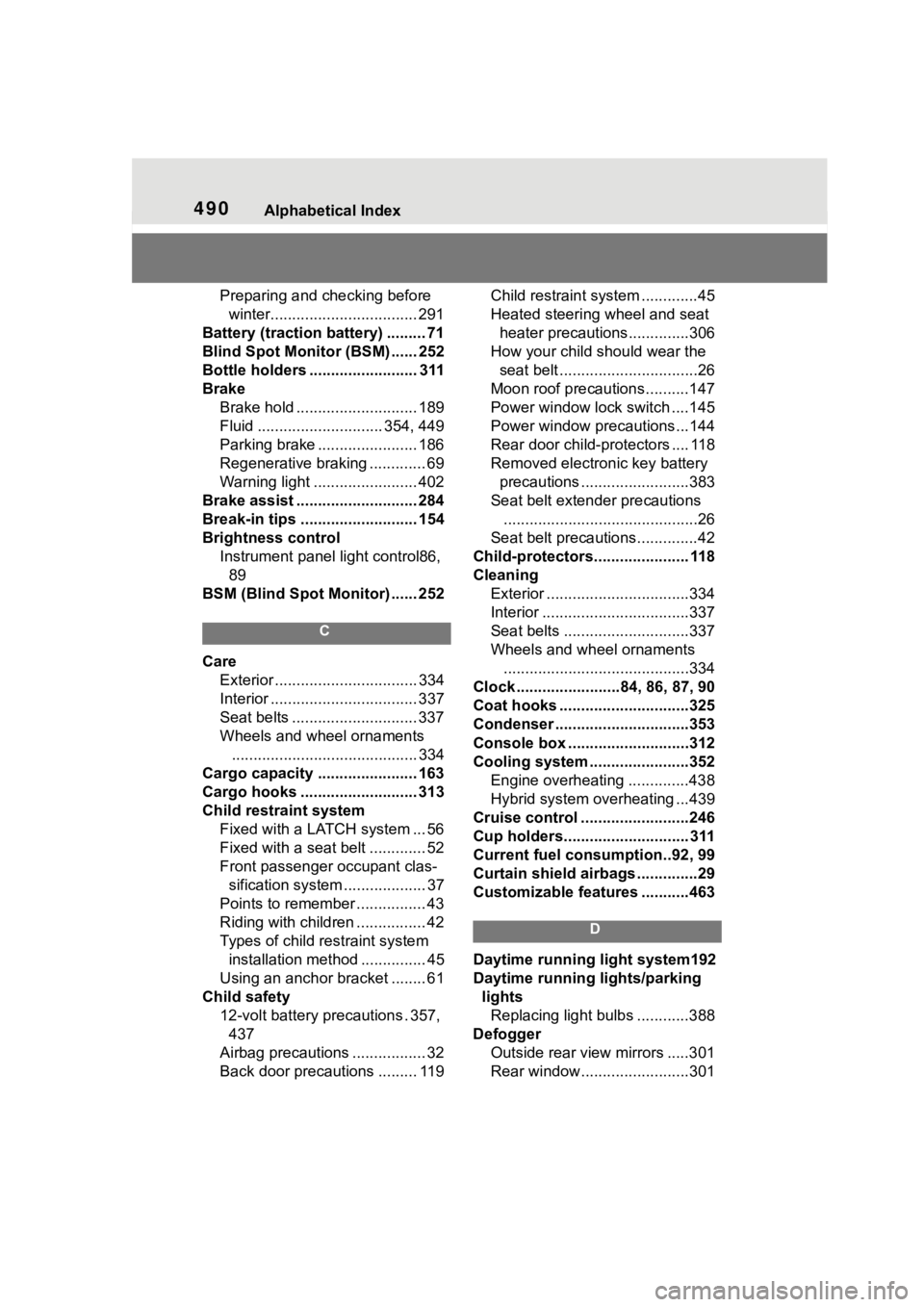
490Alphabetical Index
Preparing and checking before
winter.................................. 291
Battery (traction battery) ......... 71
Blind Spot Monitor (BSM) ...... 252
Bottle holders ......................... 311
Brake Brake hold ............................ 189
Fluid ............................. 354, 449
Parking brake ....................... 186
Regenerative braking ............. 69
Warning light ........................ 402
Brake assist ............................ 284
Break-in tips ........ ................... 154
Brightness control Instrument panel light control86, 89
BSM (Blind Spot Monitor) ...... 252
C
Care Exterior ................................. 334
Interior .................................. 337
Seat belts ............................. 337
Wheels and wheel ornaments........................................... 334
Cargo capacity ....................... 163
Cargo hooks ........................... 313
Child restraint system Fixed with a LATCH system ... 56
Fixed with a seat belt ............. 52
Front passenger occupant clas-sification system ................... 37
Points to remember ................ 43
Riding with children ................ 42
Types of child restraint system installation met hod ............... 45
Using an anchor bracket ........ 61
Child safety 12-volt battery precautions . 357, 437
Airbag precautions ................. 32
Back door precautions ......... 119 Child restraint system .............45
Heated steering wheel and seat
heater precautio ns..............306
How your child should wear the seat belt ................................26
Moon roof precautions..........147
Power window lock switch ....145
Power window precautions...144
Rear door child-protectors .... 118
Removed electronic key battery precautions .........................383
Seat belt extender precautions .............................................26
Seat belt precautions..............42
Child-protectors...................... 118
Cleaning Exterior .................................334
Interior ..................................337
Seat belts .............................337
Wheels and wheel ornaments...........................................334
Clock ................... .....84, 86, 87, 90
Coat hooks ..............................325
Condenser ............. ..................353
Console box ............................312
Cooling system .......................352 Engine overheating ..............438
Hybrid system overheating ...439
Cruise control .........................246
Cup holders............................. 311
Current fuel consumption..92, 99
Curtain shield airbags ..............29
Customizable featu res ...........463
D
Daytime running light system192
Daytime running lights/parking
lightsReplacing light bulbs ............388
Defogger Outside rear view mirrors .....301
Rear window.........................301
Page 492 of 516

492Alphabetical Index
If you have a flat tire ............. 417
If you lose your keys ............ 429
If you think something is wrong........................................... 401
If your vehicle becomes stuck ........................................... 441
If your vehicle has to be stopped in an emergency................. 395
If your vehicle needs to be towed ........................................... 397
If your vehicle overheats ...... 438
Energy monitor ....................... 105
Engine ACCESSORY mode ............. 177
Compartment ....................... 350
Engine switch ....................... 174
Hood..................................... 348
How to start the hybrid system........................................... 174
Identification number ............ 445
If the hybrid sy stem will not start
........................................... 428
If your vehicle has to be stopped in an emergency................. 395
Ignition switch (power switch) ........................................... 174
Overheating.......................... 438
Power switch ........................ 174
Tachometer ...................... 84, 87
Engine coolant Capacity ............................... 447
Checking .............................. 352
Engine coolant temperature gauge................................. 84, 87
Engine oil Capacity ............................... 446
Checking .............................. 350
Preparing and c hecking before
winter.................................. 291
Warning light ........................ 403
Engine switch (power switch)174
Enhanced VSC ........................ 285 EPS (Electric Po
wer Steering)
...............................................285 Warning light.........................405
EV drive mode.........................179
EV Driving Ratio ...............94, 101
EV indicator...............................69
EV Ratio .............................94, 101
Event data recorder (EDR) .........8
F
Flat tire Tire pressure w arning system
...........................................360
Vehicles with an emergency tire puncture repair ki t...............417
Floor mats .................................22
Fluid Brake ....................................449
Hybrid transmission ..............448
Washer .................................355
Fog lights ................................198 Replacing light bulbs ............388
Switch ...................................198
Front passenger occupant clas- sification system ....................37
Front seats Adjustment ...........................134
Cleaning ...............................337
Correct driving posture ...........23
Head restraints .....................137
Seat heaters ....... ..................306
Front side marker lights Light switch...........................192
Replacing light bulbs ....387, 388
Wattage ................................450
Front turn signal lights Replacing light bulbs ....387, 388
Turn signal lever ...................185
Wattage ................................450
Fuel Capacity ...............................445
Fuel gauge .......................84, 87